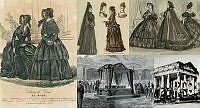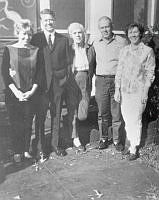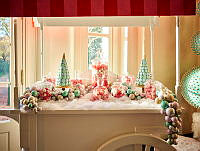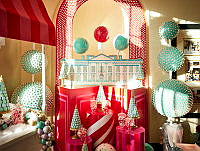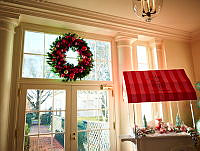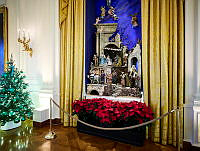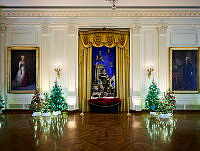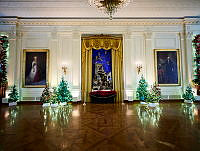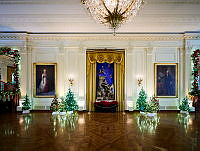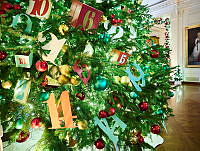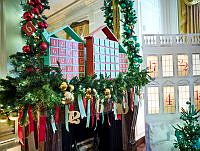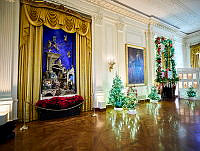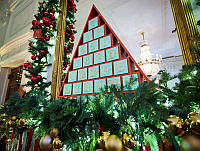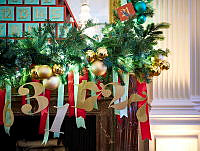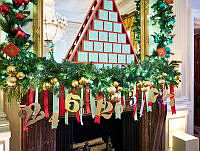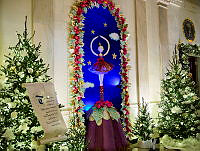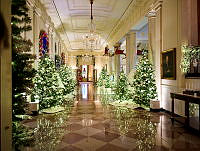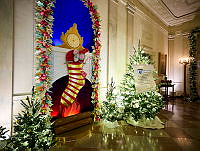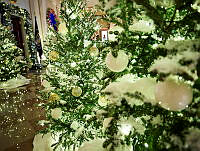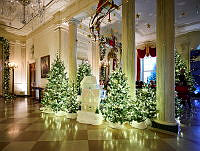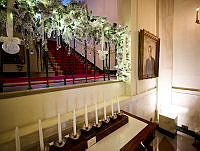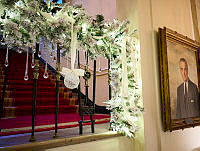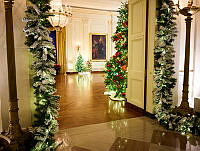John and Abigail Adams: A Tradition Begins
Copyright © Spring 2000 White House Historical Association. All rights reserved under international copyright conventions. No part of this article may be reproduced or utilized in any form or by any means, electronic or mechanical, including photocopying, recording, or by any information storage and retrieval system, without permission in writing from the publisher. Requests for reprint permissions should be addressed to books@whha.org

John and Abigail Adams had a wealth of experience in establishing and living in official houses prior to their move into the new President's House in Washington, D.C., in 1800. Adams had represented the United States in diplomatic missions to Europe during the Revolution, and in Paris and London in the 1780s when Abigail Adams joined him.
They lived and entertained in private homes in New York and Philadelphia while he served as vice president from 1789 to 1797, and when Adams succeeded George Washington as president in 1797 they moved into the house Washington had formerly occupied. Adams remained in Philadelphia until the autumn of 1800, when he and Mrs. Adams took up residence in the new Federal City of Washington, D.C. In these homes the Adamses entertained government and diplomatic officials and private citizens at the highest level of society.
New England-born Abigail Adams, like her husband, preferred books and ideas to the "fashionable life" and stated that "neither my habits nor my education or inclination have led me to an expensive style of living."1 Their interests and lives are reflected in the Old House, the Quincy, Massachusetts, home they purchased in the late 1780s and expanded under Abigail Adams's supervision between 1798 and 1800.2
Furnishings from a variety of periods and styles in the house today, accumulated by several generations of Adamses, include a Louis XV style suite of furniture acquired by John and Abigail while they were in Europe and shipped home when they returned to America in 1788. During their years in France and England they faced the arduous task of personally furnishing their residences, as Congress did not provide sufficient funds and had reduced Adams's salary. The house they rented near Paris, in rural Auteuil on the edge of the Bois de Boulogne, was an enormous stone house large enough to sleep 40 people. The walls in some of its apartments were paneled with looking glasses. It would have been very elegant, Abigail Adams wrote, if a large amount of money were spent on it, but "it is as good as we could afford."3 Silver flatware, china, glass, and tea furniture were purchased to meet their entertaining needs, as Adams's position as the American minister required entertaining once a week with a "feast in the style of the country."4

The White House collection contains several pieces from the Adamses' dinner service made by the Royal Porcelain Manufactory at Sevres, c. 1782, including this tureen, stand, and condiment stand.
White House Historical AssociationThe White House has several pieces—a tureen and stand, seven dinner plates, six soup plates, and two condiment stands—of a porcelain dinner service made by the Royal Porcelain Manufactory at Sevres, circa 1782, that may have been purchased while the Adamses were in Auteuil. Painted with colorful polychrome floral sprays and blue feather-edge borders, examples of this beautiful service were donated to the White House in 1932 by Mrs. Charles Francis Adams, the widow of John and Abigail Adams's great-grandson; additional pieces were acquired at a sale of items owned by Adams descendants in 1999.
Paris was the center of fashion, but the Adamses also imported
goods from England while in France. "Everything which will bear the name
of elegant," said Mrs. Adams, came from England.
5 When Adams became the
first American minister to Great Britain in 1785, Mrs. Adams welcomed
the changes in style. She observed that English meals were simpler,
dress not very important, and English gardens admirable. At their London
home on Grosvenor Square, the dining room provided space for 16 at
dinner and a library was used by Adams as his office.
A Sheffield silver plate tea or coffee urn from this period that descended in the Adams family until sold in the 1940s was donated to the White House in 1964. Neoclassical in form with chased and engraved floral foliage and an engraved monogram "JAA," this urn is an elegant example of the Adamses' taste. An inventory of the Old House at the time of John Adams's death in 1826 indicates that the family owned other silver and plate with the "JAA" monogram. 6

This Sheffield silver plate urn is engraved with floral foliage and the monogram "JAA." An elegant example of the Adamses' taste, it is displayed today in the Green Room of the White House.
Gift of Mr. and Mrs. Mark Bortman and Jane Bortman Larus, 1964The Adamses' personal furnishings were used in their New York and Philadelphia homes during the vice presidential years, but when Adams became president in 1797, a substantial amount of government furnishings, originally acquired for George Washington, was available and others were purchased with funds provided by Congress.
During the summer of 1800, as Mrs. Adams considered whether she would go to Washington City, she began to think about the furnishings for the new President's House, which was so much larger than the Philadelphia house. Some of the furniture, so worn that it was hardly usable, was suitable for the smaller rooms, but the larger state rooms, she wrote "required new."7 Her inclination was to take time to furnish the house and then perhaps send abroad for furnishings not available in this country. New carpets, window curtains, and looking glasses were needed, and she expressed her desire for a "superior" tea set, table china and table and bed linens. Influencing her plans was the uncertainty of the forthcoming election that would determine whether Adams would be reelected and whether they would remain in the house for four more years.

John Adams arrived in Washington on November 1, 1800, to find the
White House unfinished but habitable. Thomas Claxton, the House of
Representatives doorkeeper charged with overseeing the move from
Philadelphia and readying the house for Adams, explained that the house
was not ready because of the immense demand for goods in the city with
all the new government arrivals and that imported goods would not arrive
in the fall season. Everything had to come from great distances—even
the "most trifling articles."
8 The new city carved out of the Maryland
and Virginia wilderness was not New York or Philadelphia, where
craftsmen and goods were readily available. Claxton purchased new
carpeting, cabinetwork, and other articles to furnish the house during
the few months of the Adamses' occupancy. Congress also allocated $800
in 1800 for the stately full-length portrait of
George Washington by Gilbert Stuart that had been moved into the house before John Adams
arrived.
Despite the inconveniences of the move, Abigail Adams decided to make the trip from Massachusetts as she wanted to keep her husband company and desired to make Washington an agreeable place for others who had moved there. In the damp, cold winter of 1800 and 1801, she made the White House a home for her husband, granddaughter Susanna and President Adams's secretary, William Smith Shaw. Mrs. Adams kept warm by keeping the doors closed to her room, but lamps to light the house were lacking, and a number of things, including a tea set, had been broken or stolen en route from Philadelphia. Nearby Georgetown, Mrs. Adams wrote, "affords nothing." 9 In the second floor oval room—the Ladies' Drawing Room—sufficient furniture to welcome visitors had been placed, and it was there that President and Mrs. Adams held a reception on New Year's Day, 1801. Five days after arriving, Mrs. Adams described the room with its crimson covered furniture: "It is a very handsome room now; but when completed it will be beautiful." 10 It contained mahogany chairs, two sofas, two card tables, one Brussels carpet, two looking glasses "too small for the room," two girandoles with lamps, and a chandelier "of considerable value, not yet unpacked" according to an inventory taken a few weeks before the Adamses left the house in 1801. 11 These furnishings had been shipped from Philadelphia along with a substantial quantity of silver and plate (punch urns, waiters, flatware, candlesticks, and coffee and tea urns), three complete sets of china, and a quantity of Queen's ware.

Invitation to the reception held by President and Mrs. Adams in the White House on New Years Day, 1801. The printed blank is addressed to General Theodorus Bailey and his wife of New York. Bailey was a member of the Sixth Congress (March 1799-March 1801), which moved with President Adams to Washington. Adams' first New Years reception in the White House was to start a custom that lasted 131 years, until 1932
The White HouseAmong the cabinetwork from Philadelphia were mahogany bookcases, clothes presses, bureaus, beds, lighting fixtures, fireplace equipment, and looking glasses; most of these pieces had been secured for Washington's first residence in New York in 1789.
These federal period objects survive only in the documentary record; all were consumed in the fire set by the British in August 1814 during the War of 1812. One has to look to the Adamses' Massachusetts home for physical evidence of how they lived during and after the years they participated in the nation's life. As the first residents of the White House, they began, under difficult conditions, a 200-year tradition of making the house a home and a place in which to represent the nation, as succeeding first families have done ever since.













